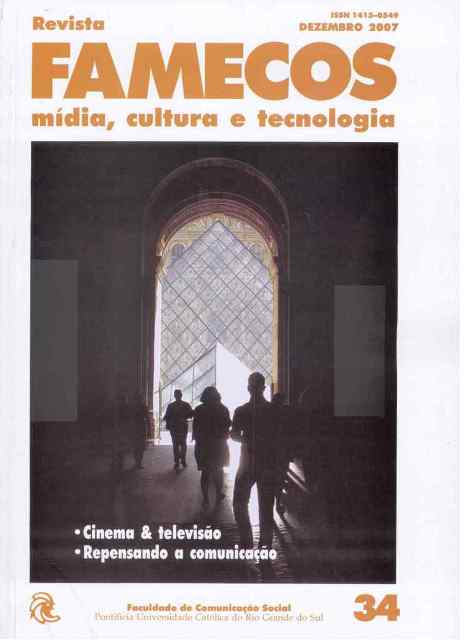The silence of television: challenge and hopes in mediated communication
DOI:
https://doi.org/10.15448/1980-3729.2007.34.3451Keywords:
Communication, public place, democracyAbstract
Much of the television communication takes place in an environment without solid references, in what differs from more traditional public spaces. In this article I reflect on the nature of communication and sociability in a mediated society and show that an inclusive and successful television culture demands from its participants a silent and interrogative attitude. In free prose, I return to interviews with authors and spectators of Brazilian soap opera made for my doctoral thesis, illuminated by a theoretical discussion about language and mediated communication, and with special emphasis on the desires and memories involved in this communication. I briefly compare the Brazilian experience with that of other countries with regard to this inclusive capacity of the communicative space, and point to the ethical and communicative challenges that are being restored today at the global level.Downloads
References
ANDRADE, Jorge. O grito. Rio de Janeiro: Globo, 1975.
ARENDT, Hannah. A condição humana. Rio de Janeiro: Forense Universitária, 2003.
BERTOLINI, Mario; GIANNAKOULAS, Andreas HERNÁNDEZ, Max. Squiggles and Spaces: Revisiting the Work of D.W. Winnicott. London: Whurr, 2001.
BRAGA, Gilberto . Anos Rebeldes. Rio de Janeiro: Globo, 1992.
BUCCI, Eugênio. Brasil em tempo de TV. São Paulo: Bontempo Editorial, 1996.
CAVELL, Stanley . The fact of television. Daedalus, 1992.
CERTEAU, Michel de. Reading as poaching. In: The practice of everyday life. Berkeley: University of California Press, 1984.
CLAIR, Janete r. Irmãos coragem: Globo, 1970.
DAYAN, Daniel and KATZ; Elihu z. Media Events: The Live Broadcasting of History. Cambridge: Harvard University Press, 1992.
FISKE, John e. Television culture. London and New York: Routledge, 1997.
GOLDFARB, Jeffrey . On cultural freedom: an exploration
of public life in Poland and America (Sobre a liberdade cultural: uma reflexão sobre a vida pública na Polônia e nos Estados Unidos). Chicago: The University of Chicago Press, 1982.
HABERMAS, Jürgen. Mudança estrutural da esfera pública. Rio de Janeiro: Tempo Brasileiro, 2003.
HAMBURGER, Esther . Diluindo Fronteiras: As Telenovelas no Cotidiano. v. 4. In: Lilia Schwarcz (Org.). História da Vida Privada. São Paulo: Companhia das Letras, 1998.
HANSEN, Miriam . Babel and Babylon: spectatorship in American silent film. Cambridge, Massachusetts and London, England: Harvard University Press, 1994.
ISER, Wolfgang . Interaction between text and reader.
In: Suleiman, SK, Crossman, I Eds. The reader in the text: essays on audience and interpretation. New Jersey: Princeton University Press, 1980.
MARQUES, Sérgio. Entrevista em Ipanema. São Paulo, 2001.
MERLEAU-PONTY, Maurice . O visível e o invisível. São Paulo: Perspectiva, 2003.
MEYROWITZ, Joshua . No sense of place: the impact of electronic media on social behavior. New York: Oxford University Press, 1985.
MUNIZ, Lauro César. Entrevista em Moema. São Paulo, 2001.
______. Os gigantes. Rio de Janeiro: Globo, 1979.
NOGUEIRA, Alcides. Entrevista na Bela Vista. São Paulo, 2001.
PRATA, Mário. Entrevista nos Jardins. São Paulo, 2001.
Pró-TV. 50 anos da televisão brasileira. São Paulo: Associação dos Pioneiros, Profissionais e Incentivadores da Televisão Brasileira, 2000.
SOUSA, Mauro Wilton de . A rosa púrpura de cada dia. 1986. Tese (Doutorado em Comunicação) - Escola de Comunicação e Arte, Universidade de São Paulo, 1986.
TEXEIRA, Mário. Entrevista em Higienópolis. São Paulo, 2000.
WEBER; Samuel . Mass mediauras: form, technics, media. Stanford, California: Stanford University Press, 1996.
WURSCH, Yoya. Entrevista na Barra da Tijuca. Rio de Janeiro, 2001.
Downloads
Published
How to Cite
Issue
Section
License
Copyright
The submission of originals to Revista Famecos implies the transfer by the authors of the right for publication. Authors retain copyright and grant the journal right of first publication. If the authors wish to include the same data into another publication, they must cite Revista Famecos as the site of original publication.
Creative Commons License
Except where otherwise specified, material published in this journal is licensed under a Creative Commons Attribution 4.0 International license, which allows unrestricted use, distribution and reproduction in any medium, provided the original publication is correctly cited.






